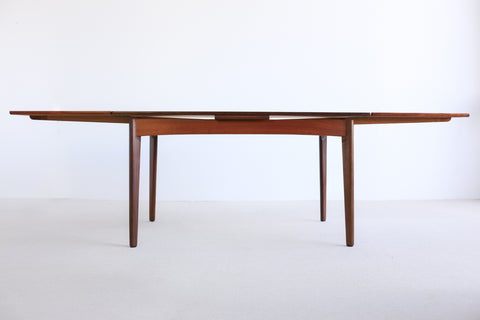Finding furniture treasures is a particularly appealing job for us, Magriet and Ali, as ex-journalists since it has so much in common with chasing a great story. One also has to investigate and research to get to the truth.
This week we found a rare and beautiful Danish dining table. When Magriet saw the advertisment online it did not state that it was Danish. From the picture it was obviously a Danish modern style piece, and the chances were good that it would be a South African derivative – it mostly is. And that is also good.
But one develops a sixth sense when you look at furniture pieces day in and day out, and when Magriet got to the table at a house in Strand, she immediately got onto her knees and crawled underneath to find what she was suspecting. A stamp: “Made in Denmark”.


For us mid-century hunters, that is base one. We’re in business. Bingo. But then you need to find out who the designer was, and which factory made it. In many instances, a sticker was used for the branding, and in this case only a tiny silver corner of a sticker was left.
This is where it gets interesting. Now we’re taking a virtual tour through the mid-century Danish furniture revolution. The first thing that you realise when you Google, is that there are many tables from different designers and factories that are almost the same design. Many of them by famous designers. Hans Wegner. Grete Jalk. Borge Mogenson. Finn Juhl.
One gets a sense that the extraordinary Danish furniture movement was not the result of rampant competition and capitalist greed, but that it was to a great extent a collaborative effort of artists who exchanged ideas, borrowed from each other, and inspired each other. It feels like there was a sense of working for “the greater good”, a unity of purpose. People in the movement were not particularly possessive of their ideas.
We found our designer after looking for a long time. No, it was not Wegner or Jalk or Mogenson or Juhl, but a lesser-known designer from a lesser-known factory: HP Hansen from Møbelindustri Randers. The clues were the legs, which are flat rather than round, and the short end of the top of the table is slightly rounded rather than square, and the rounded part is not an insertion but a part of the original piece of wood that was cut this way.
Pieces from lesser-known designers in Denmark are not necessarily of lower quality. In many instances they are even better than the large factories. In this instance, for sure.



The last piece of the puzzle was the tiny silver corner of the label that was left right next to the “Made in Denmark” stamp (in the same font as in pictures found online), exactly in the same position relative to each other than the examples online.

Hansen and Randers did a lot of work in Brasilian rosewood, but this table is in a type of rare African teak called Afromosia. As from today, ours would be the only Afromosia table of HP Hansen on the internet. And it could be yours!
See, it is not only a business, it is also a game.
To order this table, tap here.
Leave a comment